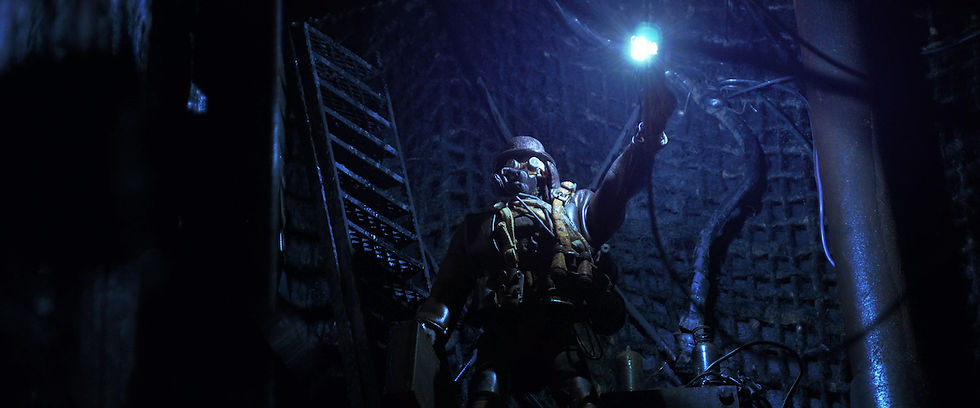A Nightmare 30 Years in the Making
- Danny Jarabek

- Aug 22, 2022
- 4 min read
Although Mad God opens with a scrolling chapter from Leviticus stating, among grisly horrors and alarming atrocities, God’s intention to lay cities in ruin and force cannibalism upon relatives should they betray Him, the biblical text is a mild precursor to the 83 minutes of feces-charged nightmare fuel that ensues. In a world that took director, creator, and visionary Phil Tippett over three decades and a Kickstarter campaign to fully realize, it only makes sense that our nameless pioneer of a protagonist would descend into the depths of hell with increasing visual vulgarity as if we are penetrating the folds and fissures of Tippett’s own cerebral cortex.

While it’s his unparalleled brain capacity to carry the patience and trauma of executing the painstaking process of stop-motion animation over the course of half his life on a passion project characterized by shit-formed peons and medical malpractice stage shows that has brought Mad God to fruition, it’s his hands crafting entire ecosystems of sublime filth that provide the transformative experience shaking its audience to the core. Submerging us into a universe of beautiful bile, the film contains references, allegories, and metaphors adding up to a lifetime career’s worth of artistic and spiritual influences, but even with the depth of inquiry into critiques on capitalism, religion, environment, and politics, unraveling the thematics falls secondhand to the pure sensory experience offered by a master of a medium. The tactility with which every set piece is orchestrated not only brings to life entire environments with textures so rich they appear to have been subjected to thousands of years of nuclear apocalyptic annihilation, but also restores and breathes a revolutionary vitality into stop-motion, a practice that by industry standard is far too archaic, expensive, and energy-intensive for significant investment. At a moment when digital simulation has reached uncanny levels of intervention in the film industry, Tippett stares square in the face of any unwritten rules in animation and paves his own path, crafting one of the most immersive cinematic journeys of the year.
Mad God cares scant about plot in a traditional sense, featuring little to no dialogue beyond the wailing cries of a baby supposedly directing mass produced laborers who face merciless deaths on the job. As one of the film’s more opaque critiques contending with the idea of the modern worker in a capitalistic economy, this society clearly doesn’t include worker’s compensation. To reinforce the idea that the antagonistic hellscape is the main character more than anyone or anything else, even our protagonist known only as the Assassin, is eviscerated by a team of surgeons who value the Hippocratic Oath with the same concern for the fragility of life as a carnivorous predator shredding into the flesh of its prey. Before this disemboweling, we are first introduced to the Assassin donning a steampunk uniform characterized by a trench coat and gas mask evoking a WWI era uniform and suggesting the landscapes he will encounter are not going to be friendly.After his diving bell transportation system finally reaches the ground, he is immediately consumed by layers and layers of decayed landscapes and rotten creatures presumed to be the waste-product of a civilization long since corroded by whatever inhabitants presumably catapulted it into a nuclear wasteland that proves friendliness is certainly not a characteristic feature of the worldbuilding. The Assassin’s movements are voyeuristic, navigating levels reminiscent of Dante’s nine circles of hell with only a rapidly wilting map. Each landscape is more harrowing than the last introducing monstrosities with protuberant scrotums and pustule inflamed flesh simultaneously alongside a godlike figure with egregiously abandoned fingernails. If all of this sounds overwhelming, that is because Tippett has succeeded in evoking a physical and emotional response through his art. The film culminates in a sequence that features nothing short of slime-ifying an Eraserhead-like newborn as an alchemic ingredient for portal-opening stardust (a sentence I never imagined writing).

Although it is never stated in any clear terms, or even vague ones for that matter, what these events mean, the film is a staggering success for its ability to translate contemporary themes such as the destruction of the environment, the exploration of western Christian iconography, and the examination of the labor principle in capitalist society through evocative imagery and precisely conducted animation. Mad God is about as far from a mainstream commercial film as physically possible, but in a just world where film is distributed and recognized on nothing but the merit of its artistic expression, it would be the poster child of cinematic creation. Never before has a post-apocalyptic environment appeared more visceral in equal parts hypnotic and horrific. Never before has an animator that has already been credited with enough material to put him in the record books as one of the most dedicated and prolific creators in the history of filmmaking pursued a project with such relentless vigor. Never before has there been a film quite like Mad God. While I believe all of these statements to be true, I also believe that they can best be encapsulated in just five words plastered on the promotional poster from Guillermo Del Toro, “Phil Tippett is a master.” The only other accurate description would be to call Tippett a Mad God himself.



